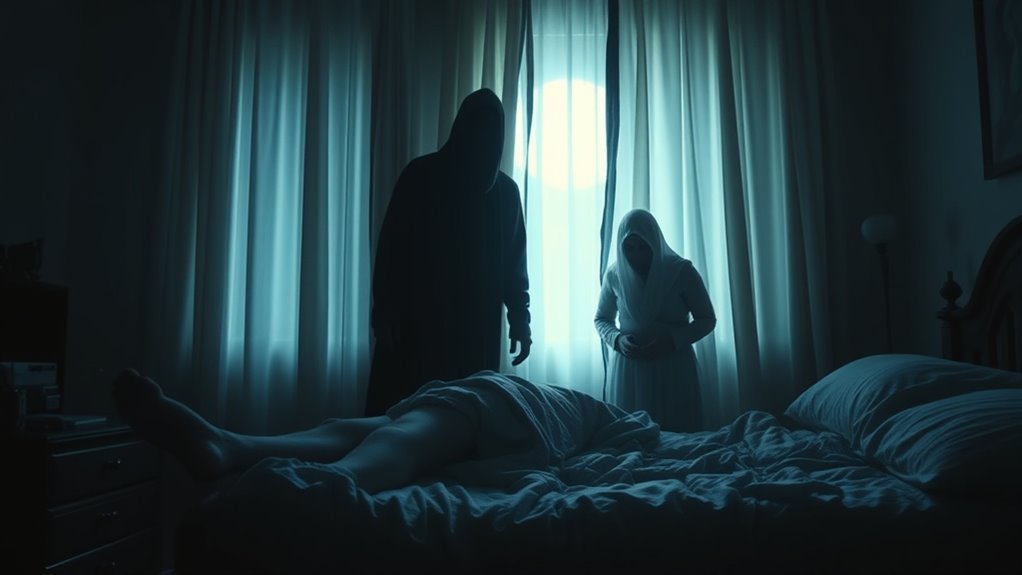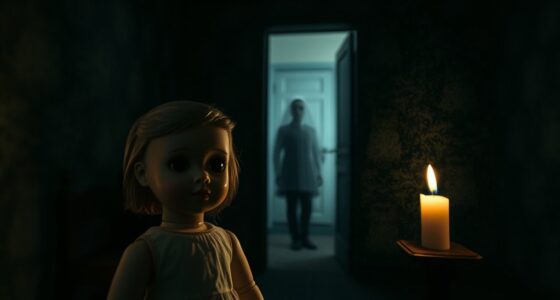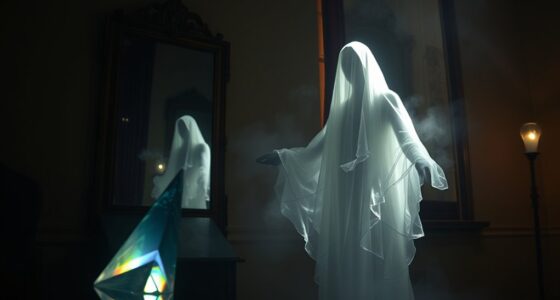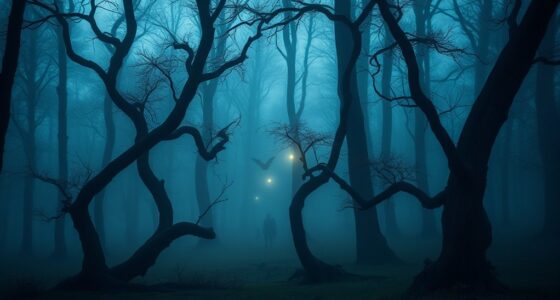Night terrors are intense episodes during deep sleep where you might scream, sweat, or sit up abruptly, often with little memory afterward. They differ from sleep paralysis, which occurs during changeover states with hallucinations and inability to move, and are rooted in brain activity involving fear and emotion centers like the amygdala. Some interpret these events as paranormal encounters. To better understand what causes night terrors and how to manage them, uncover more insights ahead.
Key Takeaways
- Night terrors involve intense fear episodes during deep sleep, unlike sleep paralysis, which occurs during transition phases with inability to move.
- Brain activity during night terrors shows heightened emotion-related region activation, resembling waking consciousness, unlike the paralysis state.
- Sleep paralysis typically includes hallucinations and awareness of the transition, whereas night terrors involve sudden, unremembered episodes of terror.
- Cultural and paranormal interpretations view night terrors as supernatural encounters, but scientific explanations attribute them to disrupted sleep cycles and brain activity.
- Recognizing the distinct features helps differentiate night terrors from sleep paralysis and addresses paranormal beliefs with scientific understanding.
Understanding Night Terrors: Symptoms and Characteristics
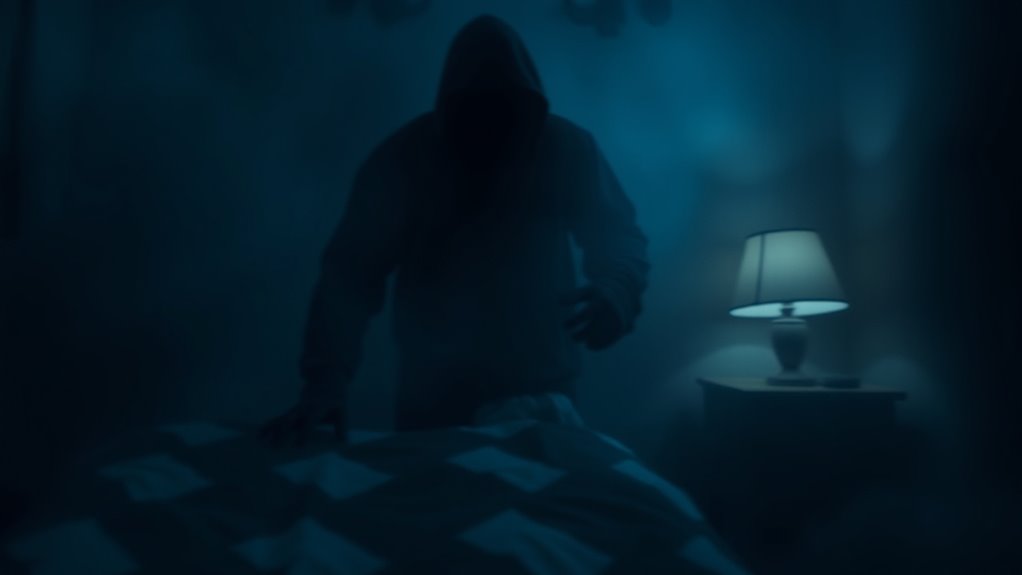
Night terrors are sudden episodes of intense fear that often occur during deep sleep, typically within the first few hours of sleep onset. During these episodes, you might experience vivid dream imagery that feels extremely real, heightening your emotional responses. You could wake up screaming, sweating, or trembling, overwhelmed by feelings of terror or helplessness. Unlike nightmares, night terrors usually happen suddenly, with little or no memory of the event afterward. Your heart races, and you may thrash or sit up abruptly, trapped in a state of panic. These episodes can last from a few seconds to several minutes, leaving you exhausted and confused. Recognizing these symptoms helps you understand that night terrors are a response to intense emotional reactions triggered during deep sleep stages. Some theories suggest that dreaming during deep sleep may involve subconscious processing of emotional stress, which can contribute to night terror episodes. Additionally, sleep disorders such as sleep apnea or restless leg syndrome can increase the likelihood of experiencing night terrors, especially when sleep quality is disrupted. Research indicates that brain activity during sleep may also play a role in the occurrence of night terrors, highlighting the complex interplay of neurological factors. It is also helpful to understand that emotional stress and trauma can serve as triggers for these episodes, highlighting the importance of managing mental health. Furthermore, disruptions in sleep hygiene and irregular sleep schedules can also increase the risk of night terrors, emphasizing the need for consistent rest routines.
Differentiating Night Terrors From Sleep Paralysis
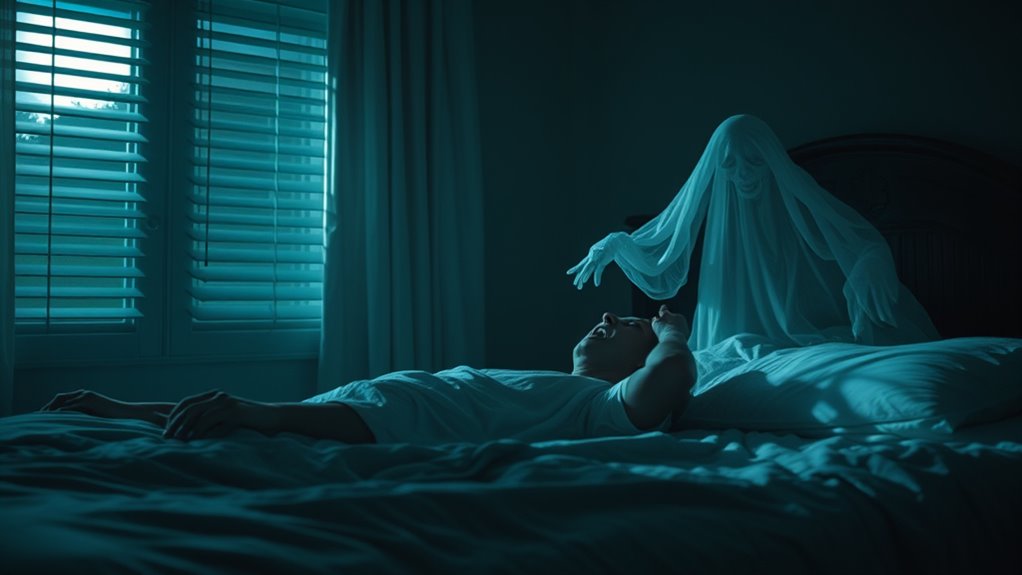
While night terrors and sleep paralysis can both disrupt your sleep and cause intense distress, they are distinct phenomena with different features. Night terrors involve sudden, terrifying episodes often accompanied by screaming, sweating, and a rapid heartbeat, usually during deep sleep stages. Sleep paralysis, on the other hand, occurs when you wake up or fall asleep and feel unable to move, often accompanied by hallucinations. You might experience a sense of dread during sleep paralysis, but you typically remain aware that you’re not in danger. Improving your sleep hygiene can help reduce both, but understanding these differences helps you manage symptoms more effectively. Unlike lucid dreaming, where you’re aware you’re dreaming, night terrors and sleep paralysis are involuntary episodes rooted in newborn sleep patterns, which can also influence the occurrence of sleep disruptions.
The Science Behind Night Terrors and Sleep Disorders
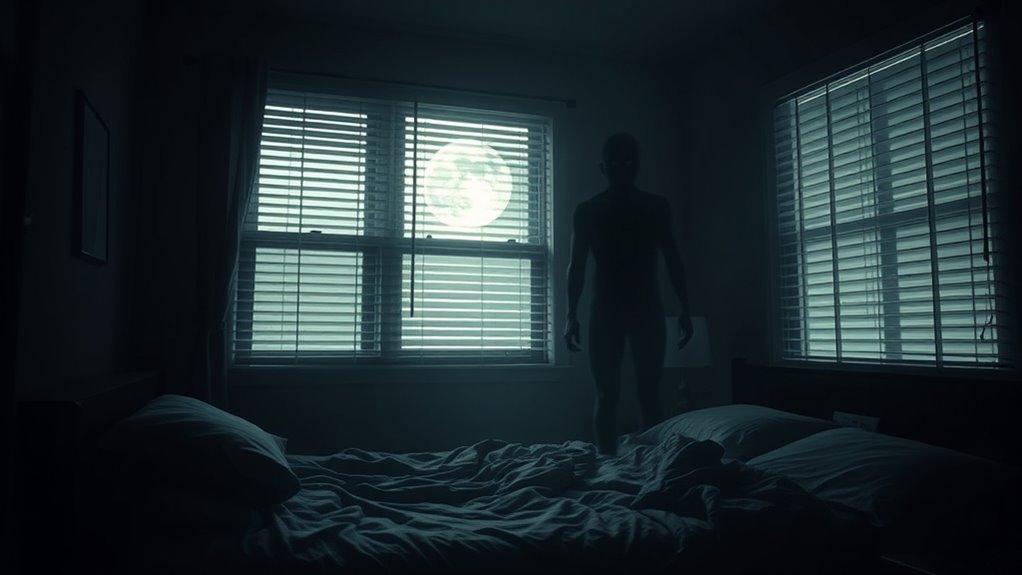
Understanding what happens in your brain during night terrors can shed light on why they occur. Disruptions in your sleep cycle often play a key role, affecting how your brain shifts between sleep stages. Recognizing common triggers and risk factors helps you manage and reduce the likelihood of these frightening episodes. Additionally, research into home cinema projectors reveals that specific features like contrast ratio and color accuracy can significantly impact visual experiences during sleep or relaxation sessions. Being aware of sleep disorders and their connection to sleep cycle disruptions can further aid in understanding and addressing night terrors. Recent AI discoveries, such as AI’s ability to manipulate quantum particles, have expanded our understanding of brain functions, potentially offering new insights into sleep-related phenomena. Furthermore, understanding hydrotherapy techniques can help in managing stress and improving overall sleep quality, which may reduce the frequency of night terrors.
Brain Activity During Night Terrors
During a night terror, your brain exhibits a distinctive pattern of activity that sets it apart from normal sleep states. You experience intense neural activation in areas linked to emotion and fear, even though your conscious mind remains unaware. This heightened neural activity often produces vivid dream imagery, but instead of typical REM sleep patterns, it involves irregular activation in regions like the amygdala and insula. These areas trigger feelings of terror and panic, fueling the frightening sensations. Meanwhile, parts responsible for rational thought and self-awareness stay subdued, which is why you can’t wake yourself or understand what’s happening. This unique neural activation pattern explains the vivid, distressing nature of night terrors and highlights how your brain’s activity during these episodes differs markedly from normal dreaming or sleep. Additionally, research indicates that brain activity during night terrors resembles that of waking consciousness more than typical sleep, further contributing to their intense and frightening nature. Understanding these neural mechanisms can help clarify why night terrors are so distressing and aid in developing effective treatments. This unusual activation pattern underscores the importance of understanding sleep disorders to better manage such episodes. Moreover, understanding these neural mechanisms can help differentiate night terrors from other paranormal phenomena, fostering better awareness and intervention strategies. Recognizing the connection between sleep deprivation and night terrors can also be useful in prevention and management.
Sleep Cycle Disruptions Explained
Night terrors occur when your sleep cycle becomes disrupted, often due to a misalignment between different sleep stages. This disruption interferes with the natural progression from deep sleep to REM, where dream symbolism becomes vivid. When your sleep hygiene isn’t ideal—like irregular sleep schedules or excessive screen time—it increases the likelihood of these interruptions. As your sleep cycles become fragmented, your brain may briefly wake during deep sleep, triggering night terrors. Understanding how sleep cycle disruptions affect your body helps explain these episodes. Maintaining good sleep hygiene promotes smoother *progressions* between sleep stages, reducing the chances of disturbances. Recognizing the importance of consistent sleep patterns can help you manage or even prevent night terrors caused by these biological and behavioral factors.
Common Triggers and Risk Factors
Certain triggers and risk factors can increase the likelihood of night terrors, especially when they disrupt your sleep patterns or stress your nervous system. Stress, sleep deprivation, and irregular schedules are common culprits. Medication effects, such as sedatives or stimulants, can also play a role. Lifestyle influences like alcohol consumption, high caffeine intake, or intense stress levels contribute as well. Understanding these factors helps you identify potential triggers. Here’s a quick overview:
| Trigger/Risk Factor | Impact on Night Terrors | Example |
|---|---|---|
| Sleep Disruptions | Fragmented sleep increases risk | Shift work, insomnia |
| Medication Effects | Altered sleep architecture | Sleep aids, antidepressants |
| Lifestyle Influences | Heighten nervous system stress | Alcohol, caffeine, stress |
Being mindful of these factors can reduce your chances of experiencing night terrors.
Paranormal Perspectives on Night Terrors
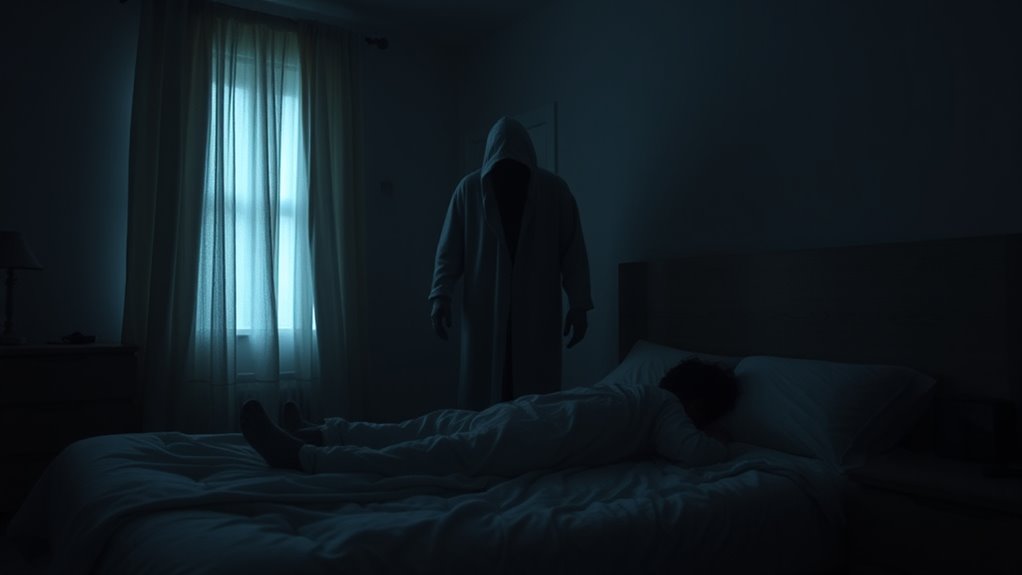
Could night terrors be more than just a neurological event? Some believe they’re linked to paranormal phenomena like alien encounters or spiritual awakenings. In this perspective, what feels like a terrifying nightmare might actually be a brush with otherworldly entities or a sign of spiritual growth. People reporting these experiences often describe vivid, inexplicable visuals or sensations that align with encounters of beings from beyond our understanding. Proponents argue that these episodes could be moments where the subconscious taps into hidden dimensions or realms, blurring the line between sleep and the supernatural. While scientific explanations focus on brain activity, paranormal viewpoints suggest that night terrors might serve as gateways to encounters with the unknown, opening a fascinating dialogue between science and spirituality.
Personal Experiences and Cultural Interpretations
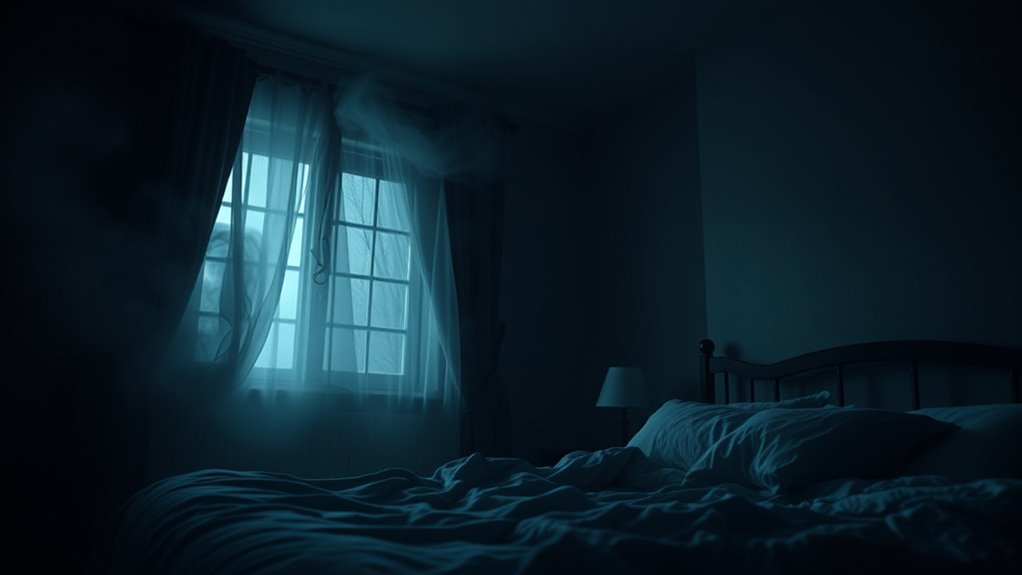
Many individuals who experience night terrors report vivid, unforgettable episodes that feel deeply personal and often culturally meaningful. These personal anecdotes are shaped by cultural beliefs, which influence how you interpret what’s happening. In some cultures, night terrors are seen as spiritual encounters or messages from ancestors, giving them a supernatural significance. Others view these episodes as the work of malevolent spirits or demons, shaping your emotional response. Your personal experiences are often colored by these cultural narratives, making the episodes more intense or frightening. These interpretations influence how you cope with and understand your night terrors. Recognizing the cultural context can help you make sense of the episodes, whether they’re seen as paranormal events or simply sleep disturbances.
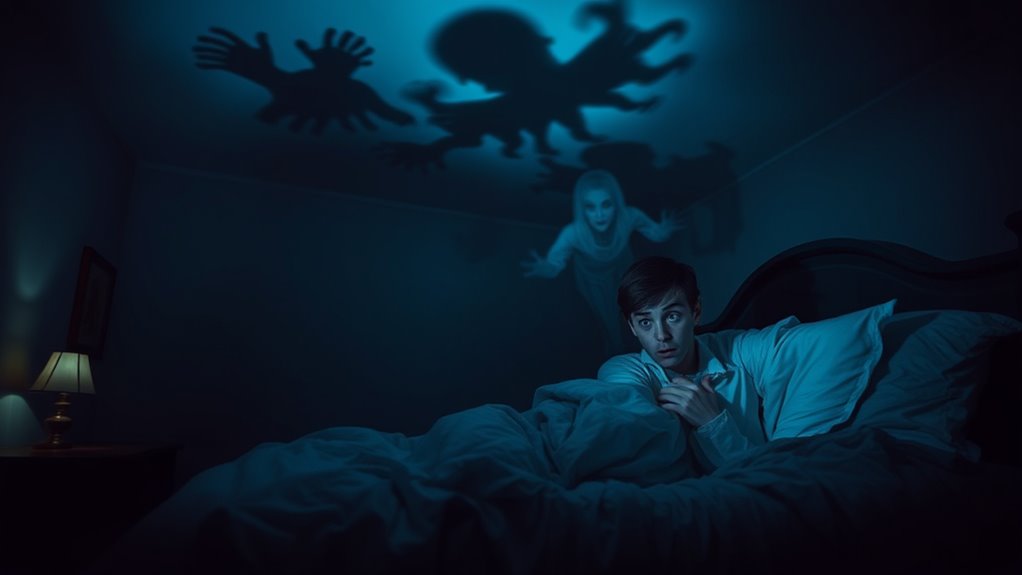
When night terrors disrupt your sleep regularly or cause significant distress, it’s important to adopt effective coping strategies and know when to seek professional help. Improving your sleep hygiene can make a big difference—stick to a consistent sleep schedule, create a calming bedtime routine, and avoid caffeine or screens before bed. Incorporating meditation techniques, like deep breathing or progressive muscle relaxation, can reduce anxiety and help you relax before sleep. If night terrors persist despite these efforts or interfere with your daily life, consider consulting a healthcare professional. They can evaluate underlying causes and recommend appropriate treatments, such as therapy or medication. Remember, addressing these episodes early can improve your sleep quality and overall well-being.
Frequently Asked Questions
Are Night Terrors More Common in Children or Adults?
You might wonder whether night terrors are more common in children or adults. Generally, night terrors are more frequent during childhood, linked to childhood development and the sleep disorder prevalence at that age. While adults can experience them too, they’re less common. As children’s nervous systems develop, night terrors tend to decrease, but in adults, they often relate to stress or other sleep issues.
Can Night Terrors Indicate Underlying Mental Health Issues?
Night terrors can sometimes signal underlying mental health issues, especially if they’re frequent or intense. If you’re experiencing them regularly, it’s wise to seek a mental health diagnosis, as they might be linked to emotional trauma or stress. Addressing any mental health concerns can help reduce night terrors and improve your overall well-being. Don’t ignore persistent episodes; they could be a sign of something deeper needing attention.
What Are the Long-Term Effects of Frequent Night Terrors?
Persistent night terrors can cause considerable consequences. You might face ongoing sleep disruption, making restful nights rare and exhausting. Emotional fatigue can build as your mind struggles to process terrifying scenes repeatedly. Over time, these disturbances can lead to anxiety, depression, and decreased daytime functioning. If you experience frequent night terrors, seeking professional help can help you break the cycle, restore restful sleep, and reduce long-term emotional and physical tolls.
Is There Any Proven Link Between Night Terrors and Paranormal Activity?
You might wonder if night terrors are linked to paranormal activity. While some paranormal theories suggest a connection, scientific research shows no conclusive evidence supporting this link. Night terrors are understood as intense episodes of fear during sleep, related to sleep disorders rather than supernatural causes. So, it’s best to rely on scientific explanations and treat night terrors through medical or behavioral approaches rather than paranormal beliefs.
How Do Different Cultures Interpret and Treat Night Terrors?
Did you know that cultural beliefs influence how people interpret and treat night terrors? In some societies, they see these episodes as spiritual encounters, while others consider them natural sleep phenomena. You might explore traditional remedies like herbal treatments or rituals rooted in cultural beliefs. These approaches reflect diverse perspectives, emphasizing the importance of understanding cultural context when addressing night terrors, instead of solely relying on Western medical explanations.
Conclusion
Think of night terrors as a storm passing through your mind’s sky—chaotic, intense, but temporary. Like a sailor steering turbulent waters, you can find calm by understanding these episodes and learning to weather the storm. With the right coping strategies and support, you’ll soon see the dawn breaking, illuminating peaceful nights ahead. Remember, even the fiercest storms eventually give way to clear skies—your restful sleep is worth the journey.
